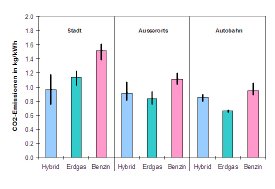Sep 14 2010
If you are looking for an environmentally friendly automobile, think about getting a hybrid car or one running on natural gas. In terms of CO2 emissions both perform significantly better than gasoline or diesel fuelled vehicles. On behalf of the Swiss Federal Office for the Environment (FOEN), Empa has conducted an investigation into the CO2 emissions of hybrid cars. When compared to natural gas fuelled vehicles, hybrids do better during inner-city driving, whereas on the motorway natural gas has the upper hand.
Hybrid cars and those fuelled by natural gas produce significantly less carbon dioxide (CO2) than equivalent vehicles running on gasoline. In the course of a study undertaken on behalf of the Swiss Federal Office for the Environment (FOEN), the results of which were recently published, Empa has investigated the CO2 emission behavior of current hybrid cars. A comparison with gasoline and natural gas fuelled vehicles concludes that hybrid vehicles are the cleanest during inner-city driving whilst natural gas fuelled cars do best on the motorway. When driven in rural areas, both types do equally well. Under mixed conditions (that is real, everyday driving) vehicles based on both concepts offer reductions of up to 25 per cent in CO2 emissions compared to conventional gasoline fuelled automobiles. Hybrid drive systems and natural gas engines therefore represent an important technical measure for reducing CO2 emissions which can be put to use immediately, as do vehicles powered by renewable fuels such as biogas and ethanol derived from waste matter.
 CO2 emissions from hybrid cars, natural gas fuelled cars and gasoline fuelled cars (3 vehicles in each category). To make the comparison more representative, the CO2 emissions are given per kWh of power delivered during the driving profile
CO2 emissions from hybrid cars, natural gas fuelled cars and gasoline fuelled cars (3 vehicles in each category). To make the comparison more representative, the CO2 emissions are given per kWh of power delivered during the driving profile
Practically-based comparisons in the laboratory
During the study, Empa engineer Robert Alvarez and colleagues compared the fuel consumption of three different hybrid cars. The fuel usage characteristics were measured on a dynamometer, both for the standard driving cycle as well as for “real world” driving profiles, which better simulate everyday driving under inner city, rural and motorway conditions. In addition, the researchers measured the amount of energy returned to the storage batteries during regenerative braking (known as recuperation) and the current supplied by the batteries to deliver extra torque to the engine when necessary.
The comparison with conventional gasoline engined cars showed that hybrids achieve up to twice the efficiency in city driving, which naturally has a very positive effect on their fuel consumption and CO2 emission levels. The repeated strong acceleration and braking phases combined with the modest speeds characteristic of urban “stop-and-go” driving particularly favor hybrid drive systems. Full hybrids, which can use purely electrical propulsion for short distances, achieved even better values under these conditions than mild hybrids, which do not have this ability, or the luxury-class hybrid evaluated in the test. Because of their weight, vehicles belonging to the latter category are generally equipped with a large internal combustion engine and a comparatively smaller electric motor.
On the other hand, during rural driving hybrids show little savings in terms of fuel consumption or CO2 emissions and on the motorway none at all compared to gasoline engined vehicles. Because of the power required to propel the vehicle at country-road or motorway speeds the electric motor is hardly able to offer any additional support to the internal combustion engine. In summary, hybrid vehicles are therefore ideal as city runabouts.
Natural gas fuelled vehicles are another alternative
In terms of CO2 emission reduction, natural gas fuelled vehicles represent another alternative, with the further advantage of significant additional economy. Technically, they are practically identical to gasoline fuelled vehicles, but they generate less carbon dioxide because natural gas contains less carbon than gasoline. Their level of CO2 emission lies about 20 to 25 per cent below that of an equivalent vehicle fuelled with petrol, but above that of a full hybrid (see figure). During rural driving conditions natural gas fuelled cars and hybrids are equally “clean”, and on the motorway natural gas fuelled vehicles actually emit less CO2 than hybrid cars. Taken over all three driving profiles, the total CO2 emission levels of natural gas powered automobiles are therefore quite comparable to those of hybrid vehicles, and when rural and motorway driving predominate then they are in fact better.